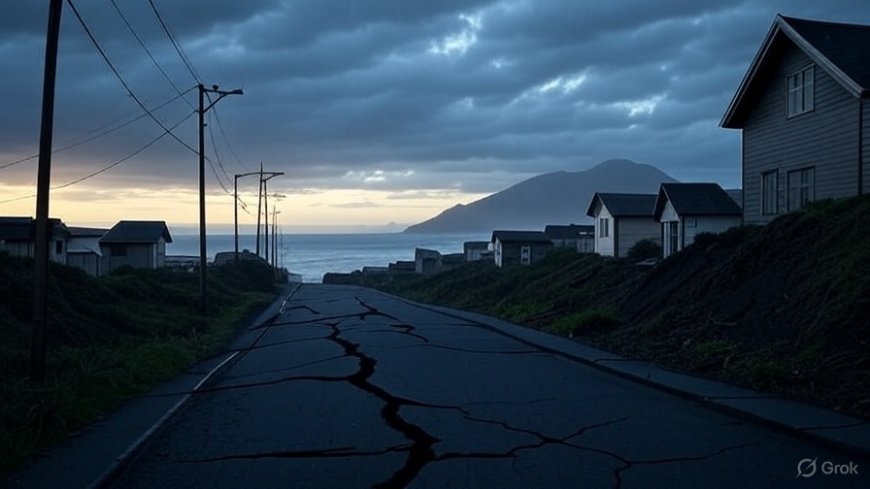Breaking - Powerful 6.7 Magnitude Earthquake Strikes Russia’s Kuril Islands, No Tsunami Threat Issued
A 6.7-magnitude earthquake shook Russia’s Kuril Islands on August 3, 2025, prompting brief tsunami concerns. Officials confirm no damage or injuries. Here’s what happened.

A Sudden Jolt in the Pacific: Kuril Islands Rocked by 6.7 Magnitude Earthquake
In the early morning hours of August 3, 2025, a powerful earthquake measuring 6.7 magnitude struck off the coast of Russia’s Kuril Islands, a seismically active region in the northwestern Pacific Ocean. The quake, initially recorded at 6.35 magnitude, was later revised upwards by global seismic monitoring agencies.
According to the German Research Centre for Geosciences (GFZ), the tremor occurred at a depth of approximately 10 kilometers, about 118 kilometers east of Severo-Kurilsk, a small town located on Paramushir Island. Other monitoring agencies, including the United States Geological Survey (USGS), placed the depth closer to 35 kilometers, adding to the complexity of assessing the potential risks.
No Tsunami Alert but Regional Warnings Briefly Triggered
Despite the strength of the earthquake, no tsunami warning was issued by the Pacific Tsunami Warning Center. However, authorities in Russia’s Kamchatka Peninsula briefly advised caution along the coast due to initial wave activity, which was later confirmed to be non-destructive.
Russian emergency services monitored coastal zones for any aftereffects, and by midday, all advisories were lifted. Residents in Severo-Kurilsk and nearby towns reported moderate shaking but no damage or injuries. The Newsonair.gov.in news portal confirmed that while the quake was felt across the region, no infrastructural harm had been identified (source).
An Aftershock of a Megaquake?
This event comes just days after a massive 8.8 magnitude earthquake struck off the coast of Russia’s Kamchatka Peninsula on July 30, which led to tsunami warnings across the Pacific, including as far as Japan, Hawaii, and New Zealand. That earlier quake sent waves over 5 meters high into parts of Severo-Kurilsk, disrupting daily life and heightening concern over further tectonic activity.
Scientists suggest that today’s tremor may be part of a prolonged aftershock sequence from the July 30 megathrust quake, which released immense stress along the Kuril-Kamchatka Trench, a well-known segment of the Pacific Ring of Fire.
Further insights from the Economic Times also noted the ongoing seismic unrest in the region and the global tsunami alerts that followed last month’s event (read report).
What Locals Experienced and What Comes Next
Residents described the quake as a short but sharp jolt, with minor indoor items shifting or falling. Emergency management teams were quick to assess buildings and infrastructure for any signs of stress or damage.
Authorities emphasized that no evacuation was needed, and normalcy was restored within hours. However, they also warned that aftershocks are likely and urged residents to stay updated through official government channels.
Tectonic Volatility in the Kurils
The Kuril Islands are part of a volcanic archipelago extending between Russia’s Kamchatka Peninsula and Japan’s Hokkaido. The region sits atop the convergent boundary of the Pacific and Okhotsk tectonic plates, making it prone to intense seismic and volcanic activity.
Historical records show the region has experienced several significant earthquakes in the past century, with events exceeding magnitude 8.0 not uncommon. The July 30 quake and its continuing aftershocks serve as a reminder of the geological volatility that characterizes the region.
Conclusion: A Wake-Up Call from the Pacific Depths
While no tsunami occurred and no casualties were reported, the August 3 Kuril Islands earthquake is a clear signal that tectonic stress is still active in the Pacific’s volatile northeast. It reinforces the need for continued monitoring and preparedness in coastal communities.
For now, the region remains stable. But as experts continue to analyze seismic data, this quake could either be a final aftershock or a precursor to future seismic activity in this highly dynamic part of the world.









